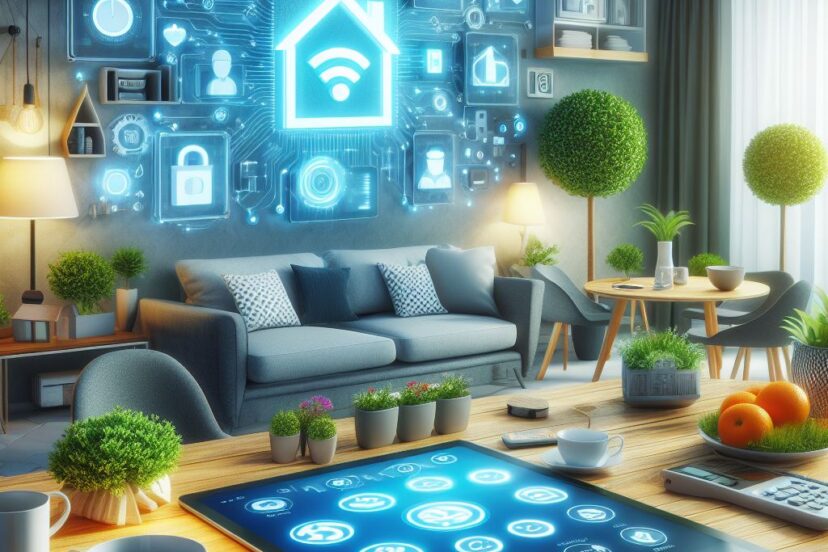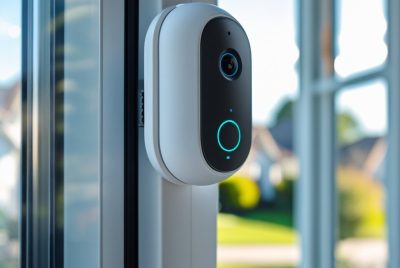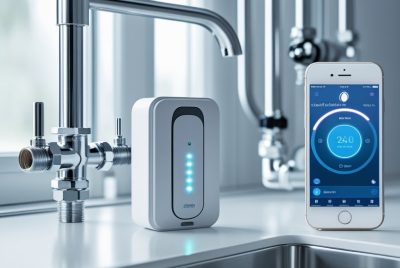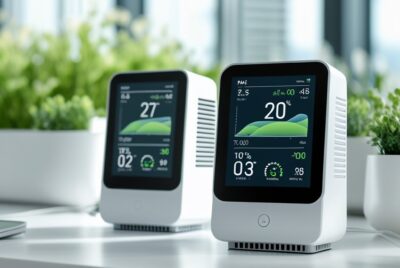Best Smart Home Devices: Top Picks for an Automated Lifestyle
*We may earn a commission for purchases made using our links. Please see our disclosure to learn more.
Best Smart Home Devices: Top Picks for an Automated Lifestyle
Smart home devices are transforming how I interact with my living space, offering both convenience and increased control. As someone who keeps up with the latest technological advancements, I’ve observed a significant evolution in the smart home industry. The market is now abundant with products that cater to every need, from security enhancements with smart doorbells and cameras to efficiency with thermostats that adapt to my routines. I find it fascinating how these devices not only automate mundane tasks but also learn from my habits, making my home more responsive to my lifestyle.

Each area of my home can be optimized with specific smart devices that contribute to a seamless daily routine. In my kitchen, for example, smart appliances can suggest recipes based on the ingredients I have on hand, while in the living room, voice-controlled smart speakers streamline media consumption and manage other connected devices through simple voice commands. The key to selecting the best smart home devices lies in understanding which products work well together, as interoperability is crucial for a truly smart home ecosystem.
Security has always been a paramount concern, and smart home technology addresses this with devices that not only deter potential intruders but also provide real-time alerts and video feeds accessible from my smartphone. With the innovation in smart locks and security systems, I rest assured knowing that my home security is more robust and manageable. While adopting smart home devices can seem daunting due to the sheer variety of options, I focus on those that offer the best performance, reliability, and ease of use to enhance my daily living.
Understanding Smart Home Devices

In this section, I’ll provide an essential overview of smart home devices, focusing on what they are, the pivotal role of connectivity, and the importance of compatibility protocols.
What Are Smart Home Devices?
Smart home devices are sophisticated gadgets that provide various automated features for a household. These typically interact with a user or other devices via an app, allowing control over functions such as lighting, heating, and security from anywhere.
- Examples of Smart Home Gadgets:
- Smart Plugs (e.g., Wemo Wi-Fi Smart Plug)
- Smart Kitchen Appliances (e.g., Cosori Smart Air Fryer)
- Smart Lighting Systems (e.g., Philips Hue Starter Kit)
- Smart Door Locks (e.g., Ultraloq U-Bolt Pro)
- Smart Thermostats (e.g., Ecobee)
- Cameras and Security Systems (e.g., Nest Cam)
The Role of Connectivity in Smart Homes
Connectivity is the backbone of a smart home system, linking smart home devices to each other and to the internet. Typically, this is achieved through a Wi-Fi network, providing the bandwidth needed for smooth operation. However, some gadgets also use Bluetooth to pair with nearby devices or hubs.
- Connectivity Methods:
- Wi-Fi: High bandwidth, ideal for most smart home devices.
- Bluetooth: Short-range, low-energy communication, suitable for simple smart home gadgets.
Compatibility and Smart Home Protocols
The ease of creating a cohesive smart home experience relies on the compatibility of devices and the protocols they use. “Matter” is an emerging industry standard aimed at ensuring devices work seamlessly together, regardless of the manufacturer. This includes voice assistants, smart thermostats, light bulbs, and locks.
- Smart Home Protocols:
- Matter: A new protocol enabling cross-brand interoperability.
- Other Protocols: Such as Zigbee and Z-Wave, which require specific hubs.
By understanding the facets of smart home devices, connectivity, and protocols, you can better navigate the ecosystem and select gadgets that suit your lifestyle.
Core Smart Home Products

In the fast-evolving sphere of smart home technology, certain devices have become indispensable for a seamless and interconnected living experience. I’ll guide you through the core products that can revolutionize the way you interact with your home.
Smart Speakers and Displays
Smart Speakers: My experience with smart speakers such as the Amazon Echo Dot has shown me their utility as central hubs for controlling other smart devices. With compatibility for voice commands via Alexa or Google Assistant, these speakers can manage tasks and provide information instantly.
Smart Displays: Devices like the Amazon Echo Show 8 deliver not only audible interaction but also visual feedback. The touchscreen adds convenience for managing daily tasks, watching videos, or video calling, all with integrated smart home control.
Smart Locks and Home Security
Smart Locks: The August Wi-Fi Smart Lock exemplifies the blend of convenience and security. It allows users to remotely manage access to their homes and monitor who comes and goes with ease.
Home Security Cameras: Enhanced security is a priority, and products like home security cameras can be monitored from smart displays or phones, providing real-time surveillance and peace of mind.
Intelligent Lighting and Switches
Smart Lightbulbs: LED smart lightbulbs can be controlled remotely, change colors, and even sync with other devices. This functionality significantly enhances the ambiance and energy efficiency of a home.
Smart Light Switches: With smart light switches, it’s possible to retrofit existing lighting to become smart. Switches with built-in WiFi require no hub and can be controlled via smart speakers or displays.
Smart Thermostats and Sensors
Smart Thermostats: The Nest Learning Thermostat is a prime example of smart climate control offering energy savings by learning your preferences and adjusting the temperature accordingly.
Temperature Sensor: Incorporating temperature sensors ensures that every room is at the ideal comfort level, while integration with smart thermostats allows for automated adjustments.
By investing in these core smart home products, managing your living space becomes more intuitive and efficient.
Ecosystems and Integration

Creating a centralized and synergistic smart home environment revolves crucially around understanding the differing ecosystems and methods of integrating various devices to achieve fluid control and interconnectivity.
Major Smart Home Ecosystems
When I mention Amazon Echo and Google Assistant, I’m referring to two of the most prominent smart home platforms available. Amazon’s Echo devices, built around Alexa, deliver a versatile voice-controlled experience that integrates effortlessly with a myriad of devices from lights to locks, such as Philips Hue and August Smart Lock. Google Assistant offers an equally powerful platform, with voice control capabilities woven through numerous smart home products.
Moving to Apple HomeKit, this ecosystem stands out for its commitment to security and privacy. Operated through Siri on devices like the HomePod, HomeKit allows for streamlined management of compatible devices, earning a reputation for providing a user-friendly and secure experience. IFTTT (If This Then That) is another service I find worth mentioning, which acts as a bridge to create custom automations across various platforms and devices.
Each ecosystem has forged partnerships with a sundry of brands, like Sonos with its new Era 100 speaker, underpinning the essentiality of compatibility in the field of home automation.
Integrating Devices for Seamless Control
My experience tells me that the integration of diverse devices hinges on ensuring compatibility and leveraging platforms like IFTTT to custom build automations. For instance, configuring Philips Hue lights to work with Amazon Alexa adds a layer of convenience, allowing for voice commands through Amazon Echo to control lighting.
Moreover, the integration isn’t limited to single platforms. Sonos Era 100 speakers, for example, seamlessly integrate with multiple ecosystems, offering flexibility in controlling your sound system. Locks such as the August Smart Lock can sync with Apple HomeKit, enabling you to secure your home with just a voice command or a tap on your Apple device.
It’s imperative to ensure that the devices you select can communicate with the central hub or voice assistant of your choice, as this determines the fluidity of your smart home experience.
Advanced Features and Technologies

In exploring the realm of smart home devices, I’ll focus on the sophistication woven into voice assistants, automation, and security that propels their utility and transforms our living spaces.
Voice Assistants and AI
Modern smart home ecosystems are increasingly reliant on voice assistants and artificial intelligence to facilitate interaction and control. Voice assistants like Amazon’s Alexa, Google Assistant, and Apple’s Siri have enhanced feature sets that extend beyond simple commands. They can execute a range of actions from controlling smart lighting to managing energy consumption. AI algorithms enable these assistants to learn from user habits, optimizing the smart home experience effortlessly.
Automation and Personalization
The automation capabilities of smart devices today are designed for high levels of personalization. For example, a smart hub can automate routines based on time or behavior, like turning off lights when I leave the house. The energy consumption of every device is calibrated to respond to personalized settings that not only bring convenience but also help in reducing energy bills.
| Feature | Description |
| Scheduled Automation | Devices can be programmed to operate based on specific times. |
| Behavioral Response | Systems learn and adapt to user patterns for greater efficiency |
Security and Privacy Considerations
When it comes to security, devices such as video doorbells and smart cameras offer more than just live footage. They now include features like package detection, facial recognition, and encrypted video calls to ensure I feel secure. While these advancements improve the safety of my home, the onus is on me to ensure that the privacy settings of such devices are robust. For instance, opting for a video doorbell with a LED display allows for clear visibility, but also requires secure encryption to prevent unauthorized access.
| Concern | Consideration |
| Data Security | Ensure strong encryption standards for all devices. |
| Privacy | Control camera and video call access through settings. |
I remain well-informed about the privacy features and limitations of my smart home devices, acknowledging that each technological advance brings with it a need for increased vigilance.
Choosing Smart Home Devices

When selecting smart home devices, my focus is on practicality, affordability, and quality based on thorough research and consumer feedback.
Deciding What You Need
I consider the specific needs in my home before purchasing smart devices. For example, if energy management is a priority, smart switches can be a valuable addition. The feature set of each device is crucial; I ensure that it serves a purpose and integrates seamlessly into my ecosystem.
Example Smart Devices for Different Needs:
- Energy Management: Smart switches
- Security: Ring Indoor Cam
Considering Affordability and Value
I believe in balancing cost with long-term value. Affordable doesn’t always mean low quality. It’s about finding the sweet spot where price and functionality align. Smart devices often come in ranges, and I always weigh the initial price against future savings and conveniences.
Affordability Checklist:
- Compare prices of similar devices
- Assess long-term value (savings on bills, durable design)
- Watch for devices that strike a balance, like a budget smart plug offering substantial energy control
Exploring Product Reviews and Recommendations
I rely heavily on reputable sources like consumer reports and user reviews. When it comes to sound quality in a smart device, for example, reviews can give me an accurate idea of performance. By consulting a variety of sources, I can get a well-rounded view of a product’s performance.
Sources I Check for Reviews:
- Consumer reports
- User reviews on product pages
- Expert reviews from tech publications
By carefully considering these factors, I select smart home devices that offer reliability, affordability, and an enhanced living experience.
Frequently Asked Questions
In my review of the smart home devices landscape, I’ve noticed an uptick in innovative features and broadened compatibility. Here, I tackle the most common queries to help you navigate this evolving market.
1. What are the top-rated smart home devices available ?
I’ve found that devices like the August Wi-Fi Smart Lock have received high praise for their balance of convenience and security features. Additionally, advanced smart home gadgets like smart air fryers are favored for their practicality and ease of use.
2. Which smart home hub is considered the most reliable for various devices?
In my experience, hubs from established brands like Amazon, Google, and Apple have demonstrated consistent reliability. They offer extensive compatibility with various smart home devices, ensuring seamless integration within your ecosystem.
3. What smart home technology advancements have emerged recently?
Recently, smart home devices have shown significant advancements in AI and machine learning, translating into more intuitive automation and personalization.
4. How do smart home systems enhance home security and automation?
Smart home systems improve security by integrating devices like smart locks and cameras, allowing for remote monitoring and control. Automation routines also increase efficiency, managing lighting, temperature, and security systems effortlessly.
5. Which smart home apps provide the best user experience and integration?
Apps by Alexa, Google, and Apple HomeKit stand out to me as they offer comprehensive control over a wide range of devices, excellent user interfaces, and robust integration options.




